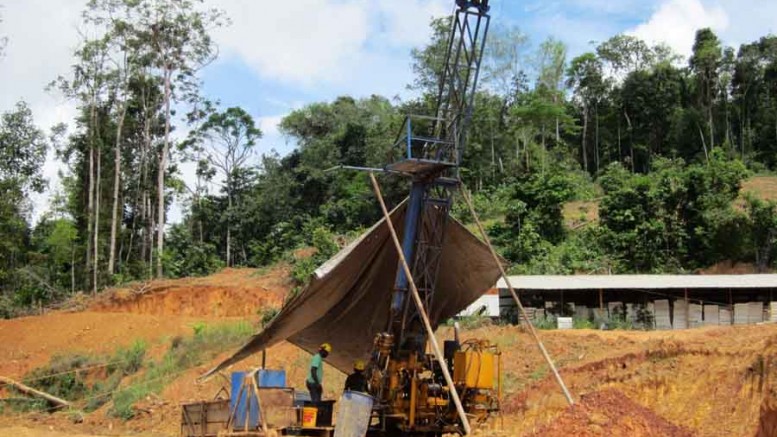After a first feasibility study scared investors with its steep price tag and shaky economics, Guyana Goldfields (GUY-T) took its Aurora gold project back to the drawing board.
The result is a new mine plan expected to cost half as much to build and generate more than twice as much in returns. Investors applauded the initiative, boosting the company’s share price by 10% in a day.
There is a lot of gold at Aurora, which lies in north-central Guyana, but the project is isolated and much of the gold is deep underground, which makes the economics of developing a mine at the site more challenging. The initial feasibility study for the project, released 11 months ago, envisioned an 8,000-tonne-per-day operation that started in an open pit but quickly transitioned to a shaft-accessed underground operation. The result was a mine that would have cost US$626 million to build, while generating a relatively low 12.6% after-tax internal rate of return (IRR).
The numbers sparked a major sell-off. Guyana Goldfield’s share price plummeted from $8.40 to $4 in the space of two weeks, and over the next two months it continued to fall, bottoming at just $1.67 in mid-May.
The project needed a rework, and that is precisely what happened. Guyana Goldfields now plans to get Aurora into operation by focusing on an open-pit operation feeding a 5,000-tonne-per-day mill and a carbon-in-leach process plant.
It should cost US$205 million to get the operation off the ground, a feat the company hopes to achieve by early 2015. Once the open-pit mine is generating income, the company will slowly work on developing a ramp-accessed underground component.
The first underground mine area would start producing ore in 2018 and eventually reach a depth of 1,037 metres.
From 2018 until 2023 Aurora would operate as a combined open-pit and underground mine. To process this ore, the mill would be expanded to a 10,000-tonne-per-day capacity. Once the open pits are tapped out in 2023, mill throughput would fall back to 5,300 tonnes per day.
Over its 17-year life, the Aurora mine would produce 3.3 million oz. gold at an average cash cost of US$527 per oz. gold. The strip ratio would average 4.7-to-1 waste to ore, and the mill head grade would average 2.7 grams gold per tonne. The carbon-in-leach facility is expected to recover 94.4% of the gold from Aurora’s fresh rock and 97% of the gold from its saprolite ore.
Using a gold price of US$1,300 per oz., the new plan gives Aurora an after-tax net present value of US$800 million. The mine would generate a 38% after tax internal rate of return, a huge improvement from the first plan’s 12.6% IRR.
With that initial capital outlay of US$205 million, the operation would be expected to pay for itself in 3.4 years. In addition, Guyana Goldfields expects to build and sustain the underground portion of the operation from cash flow. From the start of ramp development and mill expansion in 2015 to mine closure in 2031, the underground component is expected to cost US$352 million.
Aurora’s reserve estimate has been updated along with the revised development plan. Proven open-pit reserves stand at 2.38 million tonnes grading 3.04 grams gold and probable reserves total 37.1 million tonnes averaging 2.72 grams gold, of which roughly 27 million tonnes are classified as underground reserves.
The study excluded several smaller deposits, as they have not been upgraded to “reserve” status and cannot be included in a feasibility study. Rory’s Knoll, for example, has 1.1 million indicated oz. gold and 1.3 million inferred oz. gold, in addition to the proven and probable reserves considered in the study. Guyana Goldfields will keep evaluating these resources in an effort to integrate them into the mine plan.
Meanwhile, the company has a lot of work ahead to finalize the details at Aurora. Located 170 km west of Georgetown, Aurora will have to be a stand-alone operation. As such a mine at Aurora would require, among other things, a diesel and heavy fuel oil power station with a distribution system and fuel-storage facility, an airstrip, a river dyke, a tailings storage facility and accommodations for mine workers.
Guyana Goldfields has sufficient cash-on-hand to continue planning the mine, but the company says it would need to access additional funds through debt or equity to finance building the full project.
The company has also revised its management team as it transitions from an explorer to a mine developer, including finding a new president and chief operating officer in Marcel DeGuire, a metallurgical engineer with 40 years of experience building and operating mines around the world.
News of the revised Aurora feasibility study boosted Guyana Goldfield’s share price to $4.13 for a 37¢ gain. The company has 95 million shares outstanding.


Be the first to comment on "Investors like Guyana Goldfield’s new Aurora plan"